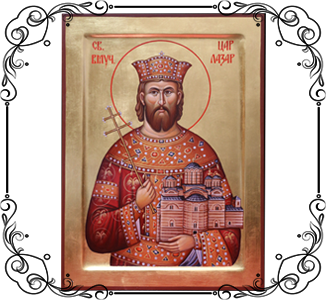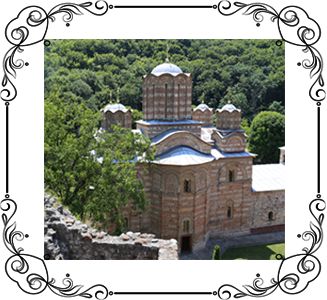Monastery Art
The Ravanica paintings show important innovations in choice of subject and in style.
The Ravanica frescoes are in a very poor state of preservation. Many have faded or flaked from the walls, and there are whole sections where none are left at all.
Nevertheless even from what has survived it is possible to see that Ravanica had a special range of compositions (with the exception of the frescoes in the sanctuary wherе the usual themes connected with the liturgy were to be found).
It is most unusual to find, as we do in Ravanica, great importance given to illustrations of Christ`s miracles. They take up most of the nave where they are given the main and most accentuated position, and are found also in other parts of the church. Even the illustrations of the great Church festivals are placed on the upper parts of the church and in the vaulting (the Entry intro Jerusalem above the south transept, and the Three Marys Bringing Myrrh to the Sepulchre at the top of the west wall), only the Dormition of the Virgin has retained its traditional place above the entrance. Scenes from Christ`s Passion are also found in the very upper levels (only two survive- The Last Supper and the Washing of the Feet).
The cycle of the miracles of Christ in the south transept includes an illustration of a Christmas hymn by St. John of Damascus. In the south part of the nave there are several scenes from the life of Virgin (her birth, the refusal of her offering and the Annunciation), and in the north transept, among Christ`s miracles there is an illustration of the parable of the Wedding of King`s Son.
In old Serbian churches, particularly those of the fourteenth century, illustrations of Christ`s miracles are very rare even in the largest churches where a maximum number of religious compositions is found. Their unusual preponderance in Ravanica was most certainly connected with the special character of the worship there. Ravanica was consecrated to the Ascension of Christ, and for its decoration the bishop, or perhaps even the patriarch, chose compositions which would be in direct connection with the liturgies celebrated by the Orthodox Church between Christ`s Resurrection and Ascension.
During these six weeks the liturgies are largely centered round a glorification of Christ`s miracles, which, according to religious explanations of that time, were linked to various of His parables. On Ascension Day there was a special celebration recapitulating the ministry of Christ, His incarnation, life, death and Ascension. The Ascension itself was shown as the final consequence of His coming to earth. This was also the reason the stress put upon the role of the Virgin Mary in the illustration of the Christmas carol and the scenes from Christ`s life. As the climax of all these very studied decorations there is, in the great dome, an illustration of the Risen Christ celebration the Liturgy in heavens while the small cupolas hold Christ and the Virgin (east) and two angels (west) who are also already in heavens.
It is certainly because of Ravanica that the miracles of Christ continued to be so widely illustrated in the churches of the Morava School, and took an important place in churches even when, unlike Ravanica, this was unconnected with the special festivals for which they had been consecrated (Sisojevac, Ljubostinja, Kalenic).
Immediately outside the sanctuary where the Church Fathers are generally shown, Ravanica contains portrayals of an unusually large number of hermits (over the whole western part of the church) and saint warriors (in both lateral transepts). The fact that such a large number of hermits were illustrated in a church which was endowed by a ruler can be explained by the religious and political conditions of the time when it was built. It is well known that Lazar`s right to rule Serbia had great support from Church and Patriarch. Patriarch Ephraim, who has then at the head of the Serbian Church and whose signature is on the Bologna transcription of the Ravanica Charter, was an ardent supporter of monasticism. He himself began as a hermit, and later left the patriarchal throne to become a hermit again. He is the most outstanding representative of the ascetic tendency among the Serbian Church hierarchy of the fourteenth century. During his reign Prince Lazar helped not only the Church and its representatives but also individual hermits. He provided refuge for the Sinaitic monks and found places for them in his various endowments: Romylus in Ravanica, Gregory in Gornjak, Sisoes in Sisojevac. Most exceptionally, the founder`s portrait of Prince Lazar and his family (on the west wall) is placed among the holy hermits. It is obvious that Lazar in this way wished to demonstrate in his foundation not only his special feelings of attachment to the monks and the Church, but also his sympathy for the attitude of Patriarch Ephraim and the Serbian Church. Finally, it must not be forgotten that when the Ravanica walls were painted it was the resting place for the relics of hermit Romylus who was already revered as a saint and miracle worker.
Pictures of the saints warriors are common in Serbian medieval architecture. But only in Ravanica do they take up the whole space in both lateral transepts. They were to keep this place- most certainly one more influence of Ravanica- in most of the later Morava churches. It was a long established practice both among Byzantine and Serbian masters to take special care in depicting the military dress and weapons of the warrior saints, and from the beginning of the 14th century they included also many details from the life of their own times. The artist were less and less included to present these warriors in a static, frontal position. They are increasingly shown in movement, even about to use their weapons.
The Ravanica paintings, in their presentation of the figures of the Saints warrior show the end of one tendency and the beginning of another. Although movement is not so accentuated here as at Resava (also known as Manasija), nevertheless they are all shown in position preceding movement or just at the beginning of movement. The struggle between Christians and Muslims, between believers and unbelievers, and the whole knightly tradition of the Middle Ages without doubt affected the approach the first active fighters for Christianity. A similar belief in the role of the Saints warriors is to be found in the literature of the period. Together with the hermit-monks who represented the ideal of Christianity, the warrior saints of Ravanica most certainly reflect the social and political conditions of Lazar`s Serbia.
The presentation of the Virgin as the source of life, is also found in contemporary ecclesiastical literature. At Ravanica she is pictured in the narthex above the entrance portal and was certainly connected with the liturgy written in fourteenth century by the Byzantine writer Nicephorus Callistus and which was celebrated in the evening services of the Thursday and Friday after Easter (one more therefore an essential part of those decorations of Ravanica connected with the Easter services).
This figure of the Virgin, with the vestiges of fourteenth-century frescoes in the two recesses of the west wall of the narthex north and south of the door, are all that is left of what Pigafetta called in 1568 the “very lovely frescoes” of the narthex.
Finally, in terms of style the paintings of Ravanica have a special place at the beginning of a new art movement which was to provide several important contributions to Serbian medieval art. At the monastery of Decani some of the frescoes, those dating from the mid-fourteenth century, already show new trends, among them a desire to depict the human figure more realistically, to achieve a certain plasticity. In the late fourteenth and early fifteenth centuries this trend was to find its greatest exponents in such masters as Metropolitan Jovan, Andreash or the unknown painter of some of the Resava frescoes. Some of the Ravanica painters also showed heightened interest in form and plasticity (the remains of the Divine Liturgy in the dome, the Healing of a Blind in the concha of the south transept, the saint warriors, etc.). But they are not all consistent. The painter of the warrior saints is more successful in suggesting plasticity in the bodies than in the faces. The painter of the Healing of a Blind, on the other hand, was more interested in the problems of facial modellation than in the figure of Christ. The face shows a softness reminiscent of an icon, while the figure gives occasion for a refined play of curved lines. Plasticity is attained in some of the medallions (the face of St. Marphanius in the south wall, or of St. Bucolus in the altar apse) either by the use of broad and free brushwork or with unexpected touches of light obtained by straight lines of white paint.
One of the most characteristic marks of the Morava style of painting is a lyrical interpretation of figures, particularly those of young people and saints, with rounded forms, an insistence on graceful and rather elongated figures, tender facial expressions and soft poses. Some of this can already be felt at Decani where some of warriors saints seem more like urbane courtiers from cultured surroundings, with sensitive faces and languid expressions, full not so much of pugnacity as of understanding. Similar tendencies are even clearer in Ravanica, and the final step was taken in frescoes of Kalenic and some of those at Resava. Here too Ravanica is at a crossroads in the development of fourteenth –century Serbian painting. Although the frescoes are damaged, this tendency can be followed not only in the work of the best painter, the one who executed, for example, the Communion of the Apostles and the Ascension, but in that of the lesser painters who were responsible, for some of medallions and the warrior saints.
Finally in some of the Ravanica frescoes a new way of attaining facial expression is found. The painting is expressionistic, and individuality is achieved through new treatment and with the help of line which no longer strictly follows the Byzantine recipe. This gave the figures a new and more expressive strength.
Through freer use of touches of color, of dark, accentuated shadows, of pale highlights, the painter achieved expressionistic faces ina way not found later in Serbian painting. This innovation in Ravanica, although it was original, seems to have been part of that powerful current in Byzantine painting of which Theophan the Greek, who worked in Russia, has until now been the best known exponent. The artist who painted Ravanica medallions did not have the gifts of a Theophan but must have had a similar artistic temperament. At times his drawing is nervous, even inept, and his use of color is less free, although he feels and uses it in a similar way. His unusual figures had no predecessors in Serbian painting not where they followed up by later painters. They remained isolated and alone.
In this unusual and somewhat heterogeneous group of Ravanica painters there was one journeyman-painter who portrayed the large figures of the prophets in the drum of the dome. He followed old traditions showing neither imagination nor power. The faces are often little more than stereotyped sketches and the use of color is superficial. His figures are static, and when they are supposed to show movement they are wooden and lifeless.
The folds of the garments and the play of line have no logical connection with the forms or movements they are meant to reveal, or with the subject they are depicting (the figures of the prophets Daniel, Hosea, Micah, etc.), or they are simply stiff, empty lines ( the prophets Solomon, David and Zechariah).
The Ravanica frescoes show considerable differences of approach to composition. It was a great master who painted the Apostles ` Communion and Ascension and he shows himself in complete control of composition. This is seen in the Communion scene in which the accent is upon the quiet and central figure of Christ, apart, and in fact already outside this world- transferring, in a most unusual way, the act of Communion itself onto the angel on one side and a young deacon on the other. It is also seen in the two groups of apostles, in which the artist skilfully varies the position of individuals and small groups. In the Assumption his approach to group composition can be seen both in the central part where the composition is fairly closed and in the two lateral groups of apostles and angels where be concentrated completely upon densityof presentation. Architectural forms in the background are reduced to the minimum, just enough to give a general indication of where the scene is taking place.
The painter of some of the illustrations of Christ`s miracles, especially those in the north-west part of the church, took a uniform approach to the problem of composition. Christ always comes from the left accompanied by a group of apostles, invariably shown in the same way and with the same movements.
Only the right hand side of each scene varies, where the miracles are shown, mostly miraculous healings. This compositional monotony, covering large wall surfaces, when surveyed as a whole, with its rhythmical repetition, in one half and variations in the other, and with its alternation of horizontals and verticals, achieves a kind of artistic expression. Taken together these illustrations seem to have a single theme in which individual pictures are only details in a larger whole- like the music of the period, a theme and variations.
The other illustrations of the miracles are however very varied, the iconography often enriched by the introduction of subsidiary figures and a wealth of detail. They are presented in a narrative, each demanding close attention. Of special interest are the Feeding of the Five Thousand and the Wedding in Cana (on the south part of the inside of the narthex).
When considering compositional technique at Ravanica two separate elements must be taken into account: on the one hand, the symbolism and theological meaning of the subjects chosen, and on the other, the skill of the painter. Artistic ability and talent stands out most visibly in the treatment of figures and of details. Although the fragmentary state of the Ravanica frescoes makes it difficult to evaluate fully the work of the artists, it is clear that there are certain innovations in the painting of the background and the architectural forms shown there.
Sometimes these simply serve to accentuate space, and even depth (the Healing of a Blind). Often, however, the architectural background has a more independent existence and a deeper artistic content of its own. Jerusalem, shown in the fine illustration of Christ`s Entry into Jerusalem (south transept) is an example of how background architecture in thus treated.
It is no longer a detail of secondary importance showing where the action is taking place, and painted so that by distribution of mass, line and color the action in the foreground is stressed. It is an artistic creation with a life, of its own breathed into it by the painter and where line and color live a full artistic life. In this illustration the ceremonial and holiday atmosphere of Christ`s Entry into Jerusalem has been carried over into the very buildings of the town.
That feeling both for the whole and for the importance of details, so wonderfully felt at Resava, is already found in Ravanica. The details of the banquet table in the parable of the Wedding of King`s Son, those of the Entry into Jerusalem and the Wedding in Cana, or the picture showing the Feeding of the Five Thousand, show how the atmosphere of an event has been captured. There is an obvious and well managed combination of observed contemporary sceneand that which had to be included in religious compositions of the day. When the artist painted the choir singing Christmas hymns (south transept) he was in fact illustrating part of the divine service of his own time – for a very similar group of choristers would stand below the illustration and accompany the service.
At Ravanica there is a new feeling for the decorative value of ornamentation. The original master-builders had worked the columns supporting the dome so that they could play an independent part in the inner decoration of the church. Later, however, the artist completely ignored the care of the builders and gave the columns a new appearance by decorating them with paintings. From old Byzantine art, particularly that of the tenth century, they borrowed the motif of the linked chain of medallions and they covered the columns with them. These circles, now large now small, in ornate frames against a blue background with gold ornamentation, climb to the roof and, with their rhythmic lines, color luxuriance and new use of ornamentation are a specific feature of the decorations of Ravanica. This innovation of the Ravanica masters was to be taken over by those of Resava and was to influence almost all-the paintings of the Morava School.
In the rich ornamentation of Ravanica the predominance of blue and yellow, so characteristic of the Byzantine illuminators of the tenth and eleventh centuries, is consistent, which certainly the old chronicler had in mind when he wrote that Prince Lazar had made Ravanica “glow with frescoes”
Another characteristic of the Morava School is the precedence of color over line and form. In this respect too, Ravanica pointed the way to something new. Although the range of colors used is not wide, and for the faces most often only dark and yellow tones are used (accentuated by haloes covered with gold) and for the rest of the pictures mainly earth colors – red and yellow, sometimes dark blue and violet tones but very little green – the use of color is new. Most of the Ravanica frescoes show the artists’ desire to get the effects they wanted through the use of color whether by delicately applied nuances, almost like the painting of icons, or through the use of widely placed color accents.
Among scholars it is generally held that one of the main Ravanica artists was Master Konstantine, whose signature is taken to be on the tunic of St. Mercurius in the north transept. As a signature, however, this is not completely reliable. Although the letters KON can be clearly read, they may be only decoration in the form of letters such as are often found in the illustrations of the Saints warriors. Whether or not this is the signature of a painter, it is quite certain that he was not the main Ravanica artist. If these letters are in fact a signature, then they show that a certain Konstantine did paint that particular saint warrior, but the saints warriors are not the best of Ravanica frescoes.
At first glance the Ravanica frescoes do not look convincing .They cover such a small surface and are in such a very bad state of preservation, to a greater extent than in any other Serbian monastery they have been repaired and retouched. One whole section of the medallions was in pare” freshened up”, and repainting is to be found elsewhere. Apart from more modern restoration they are old examples of a similar nature. On some frescoes there are clear traces of burning. All this makes our approach to them difficult.
They are, however, worth close attention. It is obvious that, taken as a whole, the Ravanica artists, however unequal they may have been in skill and talent, were all (with the exception of the one who painted the prophets in the dome) trying to find a new approach to the artistic problembefore them. They drew inspiration from ancient sources (the linked medallions and their coloring), mingled with them echoes of works of art of their own or a slightly earlier time and also of the literature and whole atmosphere of their time. Of course, the artists of Ravanica cannot take credit for all these innovations. Some of these things, as we have already suggested, are to be found in the work of other Serbian painters of the end of the first half of the fourteenth century.
Byzantine influence, especially that of the Constantinople area, is unquestioned. It may be seen in the borrowing of old Byzantine motifs of the tenth, eleventh and beginning of the fifteenth centuries, or in echoes of new alt trends that suggest the paintings of Theophan the Greek. There are similarities too with paintings in the churches of Salonica, and especially those in the narthexof the Nea Moni, which is only a little older than Ravanica. But these similarities are mainly confined to individual iconographic types (the figure of Christ in the composition showing the Healing of a Blind in Ravanica is very similar to the Christ type in illustrations of his miracles in the Nea Moni). But apart from this Byzantine current, now stronger now less strong, there is no doubt that Ravanica is primarily the logical ending of the development of Serbian fourteenth-century painting.
From the middle of that century Serbian artists were seeking new, more individual forms of expression. And it is this constant search, and this lively interest for the new and for a fresh kind of expression which is the main feature of Serbian art of the second half of the fourteenth century.
We have inherited a completely impoverished Ravanica, shorn of its once rich interior decorations, of its icon large and small against gilded silver, its golden crosses embossed with precious gold embroideries on crimson altar cloths.
It was these rich and colorful church furnishings which together with the frescoes gave the impression to one old chronicler of “a flower that can never fade”.
But even this maimed Ravanica, several times destroyed in the course of a long history in which it shared the fate if the Serbian people, stands witness to the exceptional creative powers of our ancestors who, in the difficult days when they were fighting for their very existence, in a truncated state, menaced from all sides, found the strength to create works of art full of spirit and energy.
A legion of artists – builders, painters, goldsmiths, sculptors and embroiderers – gave to Ravanica their knowledge, talent, skill, and at the same time left for us a record of the spirit of times when people knew how to live, to create and to die in dignity, a record of those forefathers of ours of whom a contemporary wrote:
“…THOSE WERE IN TRUTH NOBLE MEN,
COURAGEOUS MEN,
AND FULLY MEN IN WORD AND DEED…”



